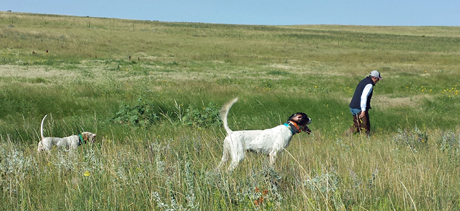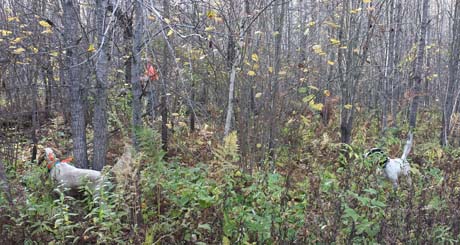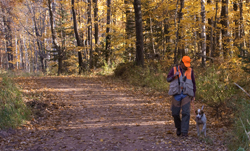A brace of bird dogs

On the North Dakota prairie, Frank LaNasa flushes for brace mates True Confidence, on left, and Northwoods Grits on a divided find.
Any sportsman will tell you that two dogs find more birds than one dog.
~ Er M. Shelley, Bird Dog Training Today and Tomorrow, 1921
It seems that hunters and field trialers have commonly had two dogs on the ground at the same time for a long, long time. And for good reasons. Not only is the whole thing more productive but it truly is the epitome in working pointing dogs. Finding a bird dog on point while another backs is a beautiful sight.
Even though the noun “brace” has many meanings—from clamp and support beam, to things medical, mathematical, musical and nautical—for us, the key definition is “a pair of like things.” Hunting two or more bird dogs together is a brace.
Whether handled by the same or a different person, there are several considerations when bracing dogs. Chief among them is that not just any two dogs will make a good brace.

In the thick grouse woods, it’s memorable to come upon a fine piece of bird work by brace mates Northwoods Blue Ox on point, backed by Northwoods Carly Simon.
Good brace mates.
• The dogs should hunt independently yet be cognizant of what the other is doing so both can get in on any bird work.
• It’s perfect if one dog ranges wider and one is closer so more ground is covered more thoroughly.
• Easy handling dogs are best. At a minimum, one should be an experienced, almost automatic dog.
• The dogs must back their brace mates on point.
Bad brace mates.
• Competitive dogs are difficult in a brace. Some dogs are even more competitive to a specific dog.
• Two young males braced together can become quite a kerfuffle.
• Some dogs pay more attention to the other dog than to their task.
• When the same dogs are hunted together frequently, one might depend on the other to find birds and is content to back.
Another consideration.
Two dogs will not only cover more ground but they’ll usually do it at a faster pace than if run singly. They might tire more quickly—which then might require more dogs to hunt the same amount of time.
Finally…
How to know what dogs brace well together? Try them!




